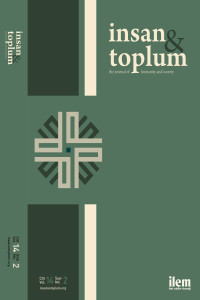Ne Dediler? Ne Demek İstediler? Avrupa'daki Tarihi Dönüm Noktalarında Başkanların Söylemleri Üzerinden ABD Politikalarını Yorumlamak: Demokrasi Nitelikleri Üzerine Bir Çalışma
Öz
Bu çalışma, ABD Başkanları tarafından Avrupa’da kritik ve tarihsel kırılma noktalarında yapılan konuşmalarda demokrasinin niteliklerinin nasıl kullanıldığını incelemeyi hedeflemiştir. Amaç, konuşmaların içeriğini analiz etmek ve demokrasi nitelikleri açısından kuvvet kullanımı vurgusunda bir değişiklik olup olmadığını ortaya çıkarmaktır. Çalışma, kuvvet kullanımına ilişkin öngörüleri izleyerek, Rusya-Ukrayna Savaşı’nın geleceğine yönelik ABD politikalarının izdüşümünü ortaya çıkarmaya çalışmaktadır. Analizlere dâhil edilmek üzere, Reagan’ın (1987) ve Clinton’ın (1994) Brandenburg konuşmaları ve Biden’ın (2022) Varşova konuşması seçilmiştir. Seçilen konuşmalar, Maxqda programı aracılığıyla, küresel demokrasi endekslerinin nitelikleri üzerinden analiz edilmiştir. Analiz sonucunda, odaklanılan demokrasinin niteliklerinin ve genel kapsama alanının zaman içinde değiştiği bulgusuna erişilmiştir. Özetle analiz, Clinton ve Reagan’ın konuşmalarındaki ‘kuvvet’ kodunun frekansının, Biden’ın konuşmasında ‘güç’ koduyla değiştiğini göstermiştir ki bu da caydırıcılık için Rusya Ukrayna savaşında potansiyel askerî gücün desteklenebileceğinin ancak Rusya’ya karşı fiziki olarak (ABD tarafından) kuvvet kullanılmayacağının göstergesi olarak kabul edilebilir.
Anahtar Kelimeler
Siyasal iletişim demokrasi ve kuvvet kullanımı demokrasinin nitelikleri ABD Başkanlarının Avrupa’daki konuşmaları Maxqda ile analiz
Kaynakça
- Andersen, D., Møller, J. & Skaaning, S.E. (2014). The state-democracy nexus: conceptual distinctions, theoretical perspectives, and comparative approaches. Democratization, 21(7), 1203–1220, DOI: 10.1080/13510347.2014.960206.
- Beetham, D. (1999). Democracy and Human Rights. Cambridge: Polity,18.
- Bracciale, R. & Martella, A. (2017). Define the populist political communication style: the case of Italian political leaders on Twitter, Information. Communication & Society, 20(9), 1310-1329, DOI: 10.1080/1369118X.2017.1328522.
- Bucy, E. P. & Evans, H. K. (2022). Media-centric and Politics-centric Views of Media and Democracy: A Longitudinal Analysis of Political Communication and the International Journal of Press/Politics. Political Communication, 39(2), 254-265, DOI: 10.1080/10584609.2021.1966595
- Dai, Y. & Kustov, A. (2022). When Do Politicians Use Populist Rhetoric? Populism as a Campaign Gamble. Political Communication, 39(3), 383-404, DOI: 10.1080/10584609.2022.2025505
What Did They Say? What Did They Mean? Interpreting US Policies through Presidents’ Discourses at Historical Landmarks in Europe: A Study of Democracy Attributes
Öz
This study investigates how US Presidents addressed the attributes of democracy in their speeches at critical European sites and historical breakpoints. The aim is to analyze the content of the speeches and determine whether there is a change in the emphasis on attributes related to the use of force. By examining projections related to force use, the study seeks to identify traces of US policies for the future of the Russian-Ukrainian War. Three speeches were selected for analysis: Reagan’s (1987) and Clinton’s (1994) Brandenburg’s speeches, and Biden’s (2022) Warsaw speech. They were analyzed using the attributes of global democracy indices through the Maxqda program. The findings indicate that the focused attributes of democracy and the overall comprehensiveness of attributes have changed over time. In summary, the analysis reveals that the frequency of the code ‘force’ in Clinton’s and Reagan’s speeches has shifted to the code ‘power’ in Biden’s speech. This suggests that the potential military power for deterrence may be strengthened, yet it is not intended for physical deployment in the Russian-Ukrainian war as a means of force.
Anahtar Kelimeler
Political communication democracy and force use the attributes of Democracy US Presidents’ speeches in Europe Maxqda analysis
Kaynakça
- Andersen, D., Møller, J. & Skaaning, S.E. (2014). The state-democracy nexus: conceptual distinctions, theoretical perspectives, and comparative approaches. Democratization, 21(7), 1203–1220, DOI: 10.1080/13510347.2014.960206.
- Beetham, D. (1999). Democracy and Human Rights. Cambridge: Polity,18.
- Bracciale, R. & Martella, A. (2017). Define the populist political communication style: the case of Italian political leaders on Twitter, Information. Communication & Society, 20(9), 1310-1329, DOI: 10.1080/1369118X.2017.1328522.
- Bucy, E. P. & Evans, H. K. (2022). Media-centric and Politics-centric Views of Media and Democracy: A Longitudinal Analysis of Political Communication and the International Journal of Press/Politics. Political Communication, 39(2), 254-265, DOI: 10.1080/10584609.2021.1966595
- Dai, Y. & Kustov, A. (2022). When Do Politicians Use Populist Rhetoric? Populism as a Campaign Gamble. Political Communication, 39(3), 383-404, DOI: 10.1080/10584609.2022.2025505
Ayrıntılar
| Birincil Dil | İngilizce |
|---|---|
| Konular | Amerika Çalışmaları |
| Bölüm | Araştırma Makaleleri |
| Yazarlar | |
| Yayımlanma Tarihi | 7 Haziran 2024 |
| Yayımlandığı Sayı | Yıl 2024 Cilt: 14 Sayı: 2 |


